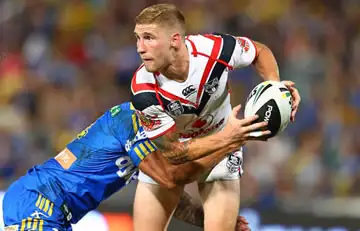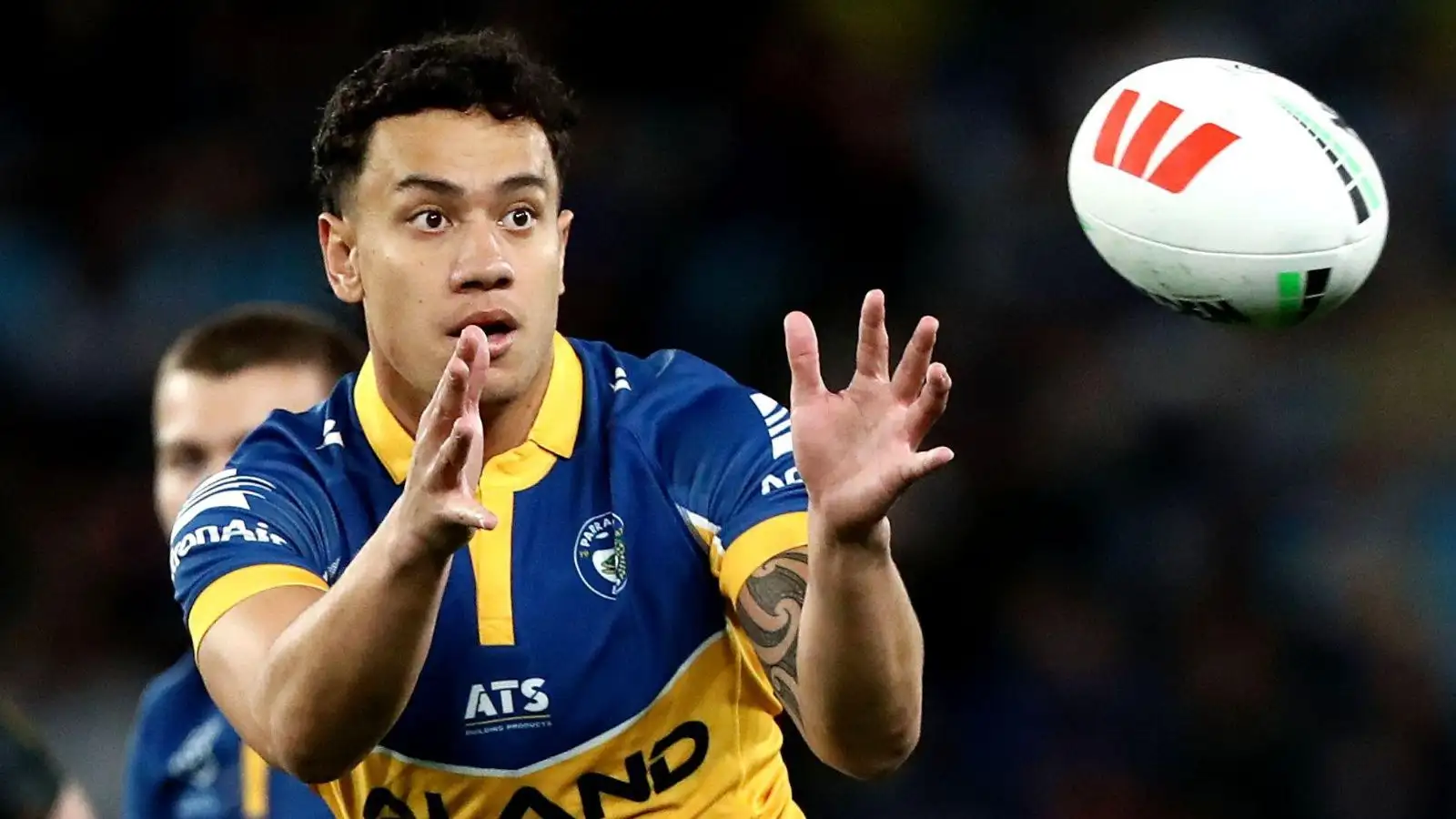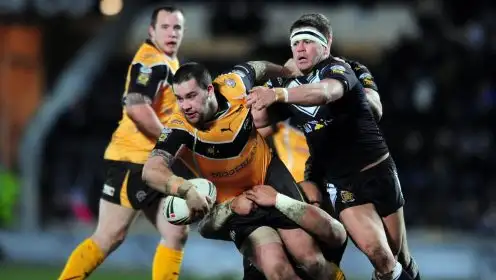Rugby League Week #18 – Marquee, Moon and television

I’m sorry. For someone who spends a sizeable chunk of each day thinking up atrocious puns for headlines, the temptation was too great.
In a week when Dr Koukash’s campaign for a so-called ‘marquee rule’ got nodded through at the fourth time of asking – by eight Super League clubs to four – it was obvious what the main theme of this column had to be.
But following as it did on the back of Joel Moon’s one-match suspension for making ‘dangerous contact’ with Josh Charnley during last weekend’s Leeds-Wigan clash in Newcastle, an open try-line beckoned.
All it needed was a little additional nod from yours truly as to how well Sky Sports covered the Magic Weekend and – voila! – job’s a good ‘un. A crow-barred reference to a seminal punk album of the 1970s was there for the taking.
A little further reflection, though, invites the thought that the three subjects above aren’t entirely unrelated.
Most obviously, the marquee rule is intended to put a spring in the step of the top flight, to give it a bit more star power, to put bums on seats whether that be in stadiums or front room sofas while sucking down a Kingstone Press cider.
And amid industry buzz that Sky’s viewing figures for rugby league have this year dipped significantly, you can see why that may be necessary.
Yet I can’t help but feel that allowing every club to buy in one player all-but free of the current £1.85 million salary cap (those signings will be valued at £100,000 for club-trained players and £175,000 for non club-trained) is merely fiddling while Super League burns.
Make no mistake. This has been the closest Super League in years and, as a result, highly entertaining. So I do understand where the clubs who said nay – Wakefield, Castleford, Huddersfield and Hull –are coming from.
In essence and with the obvious exception of Wakey (whom the arrival of Brian Smith may yet turn around via potential player loans from his array of British coaching disciples), this is the comp we’ve waited years for.
So why muck about with something that is so obviously working well? Yes, the table at this stage of the season is pretty much an exact replica of how the ‘top 12’ stood in 2014, but the margins on that ladder are much narrower.
There’s a distinct feeling that anything could yet happen which, of course, is exactly what you are looking for in sport, and that mood of anticipation ought only to ramp up further with the approach of the middle 8s.
So far, so good then. But the fact does remain that – currently at least – the much-heralded structural changes are not delivering a major boost to attendances nor, by the look of it, those aforementioned TV viewing figures.
And if, say, Huddersfield and Catalan Dragons were to reach a Grand Final staged in Manchester on the very same night that England play Uruguay across town at the Etihad in the Rugby Union World Cup, then scramble for cover.
If the New Era really is going okay (in what is its first year, it must be said), that is largely by preaching to what remains of the already converted.
The fact is that on any given weekend, only around 70,000 people are enticed from those armchairs and out to a rugby league ground in this country, most of them in a geographically specific region. There’s nothing wrong with that. It is what it is. But pretending otherwise is an exercise in self-delusion.
League’s task, then, is to grow that supporter base as sustainably far and wide as it can, certainly if it wants to stop living hand to mouth, depending on hand-outs and attract the level of financial investment that its athletes deserve.
It will achieve all of this in two very obvious ways, it seems to me.
One is to get more people involved on the ground, whether playing the game or as volunteers, launching and running community clubs, sponsoring local efforts, spreading the word.
And the second route is via greater promotional activity. That’s why the 2015 Magic Weekend was such a raging success. By taking Super League to a new audience and supporting more modest activity already in the North East at the likes of Cramlington Rockets around ten miles north of Newcastle, for example, it satisfied both sets of criteria at a swoop.
Super League is still the shop window, however important and vibrant the Championship is or becomes. And as a result it’s where British rugby league as a whole – maybe even European rugby league – will stand or fall.
So why, then, would we limit our top-flight clubs to one ‘marquee’ player? Though we should always be mindful of the predicaments of strugglers and help them when we can, why would we let them set the agenda? Surely we should be motivated by excellence, not the lowest-common denominator?
After all, those future spectators, investors and broadcasters won’t begin to take greater or indeed any interest at all in league simply because it has the air of a well-run corner shop. They will covet, excitement, colour, glamour…
They’ll want whole teams of superstars and household names at that.
The flip side to that argument, of course, is that any sport or competition within it is only as strong as the weakest link. We’ve already ditched two clubs from Super League and there remains a strong argument that in doing so we were a couple too light, ten being the optimum top-flight amount intensity-wise.
If professional and semi-professional rugby league simply allows its bottom end to drop off, then what happens as the decay creeps ever nearer the top? Will we one day be left with, say, a top four or even two clubs, big fish in a stagnant and all-but empty pool?
So stagnant that they are left with little choice but to swim away to rugby union, perhaps, or an increasingly powerful and cash-rich NRL? The sort of thing, in fact, that is already happening in France?
For all that Leigh look to have the financial muscle to compete in 2016 (should Mr Smith not work his Belle Vue miracles), growing speculation about Dr Koukash’s future at Salford with – wait for it – the KC Stadium now being mentioned as a likely destination, is also intriguing.
Wouldn’t that be something? Not only would Super League’s bottom pair most likely be skint in such a scenario, but the good doctor, as Sky like to call him, would be off to a club who actually voted his marquee proposal down.
Rugby league, eh? Never a dull moment.
For we who are aware of its existence anyway.
Which again brings us to where we came in.
Super League, like all major and wannabe major professional sports, is showbiz. And like all elements of show business it can not only continue to exist but also hopefully thrive if it makes a success of the box office. And that will only be achieved when the show on offer is stimulating, attractive or preferably both.
To that end, we need to ask if the sport in its current form really would be as enthralling to a general Joe or Joanna as we like to tell ourselves it is.
Is it, for example, a good idea that referees and other officials should look younger than players? Is that a good way of earning on-field respect and thereby gaining control of the sort of testosterone-charged atmosphere that marked Leigh and Featherstone’s bad-tempered boreathon in Blackpool the other week?
Take a look at cricket, union, American football even … don’t those sports’ on-field officials not carry a dash more gravitas?
Couldn’t the actual playbook be shaken up a bit to make passages of play a little more random, less predictable and formulaic?
And couldn’t there be just a little more consistency – always open to interpretation and circumstance I know – when it comes to on-field rules, as in the case of Darrell Griffin’s sending-off against Widnes last weekend, and the seldom less than mindboggling disciplinary process that follows?
Everyone at Leeds thinks Joel Moon was badly done to. Everyone at Wigan does not, while conceding that Charnley’s tattooist might merit a sine die ban. No one at Huddersfield can understand why Scott Grix gets a game merely for tackling Morgan Escare, or why Remi Casty escapes scot free.
It gives the impression of a sport making things up as it goes along and, frankly, looks silly – again, at least to those who take any notice at all.
Over and above all of this then, lie the two challenges I referred to at the start, neither of which will we achieved by getting bogged down in accountancy.
To be persuaded otherwise is to risk tying the sport up in unnatural knots from which workarounds will always be sought, hence the new marquee rule.
Leaving aside how divisive it may turn out to be in dressing rooms – good luck with moulding that whizz-bang young rugby union talent into your precious ‘team ethos’, by the way – the monies involved are way too low to attract genuine top-line celebrity performers.
In a week when Manly’s Daly Cherry-Evans, for example, did a backflip on an agreed move to Gold Coast Titans in return for a ‘lifetime deal’ worth as much as $10 million, who could doubt that?
And more to the point, who among the UK public will have even heard of DCE or eagerly turn out to watch him if he suddenly signed for Widnes?
In any case, this is supposed to be ‘Super’ League remember. Where, by definition, every player ought to be considered a marquee attraction.
No, the real job facing Super League is to rely less on gimmickry, pull what is already a pretty compelling spectacle in line with other British sports, ditch the salary cap completely and then get out there and sell it in the real world.
Now, where did I put that record player?
Tone’s Tips: Victories for Widnes, Warrington, St Helens, Hull KR, Huddersfield and Leeds. RFL to issue ‘exciting’ press release that Magic Weekend 2016 will relocate from Newcastle to the Shay.



